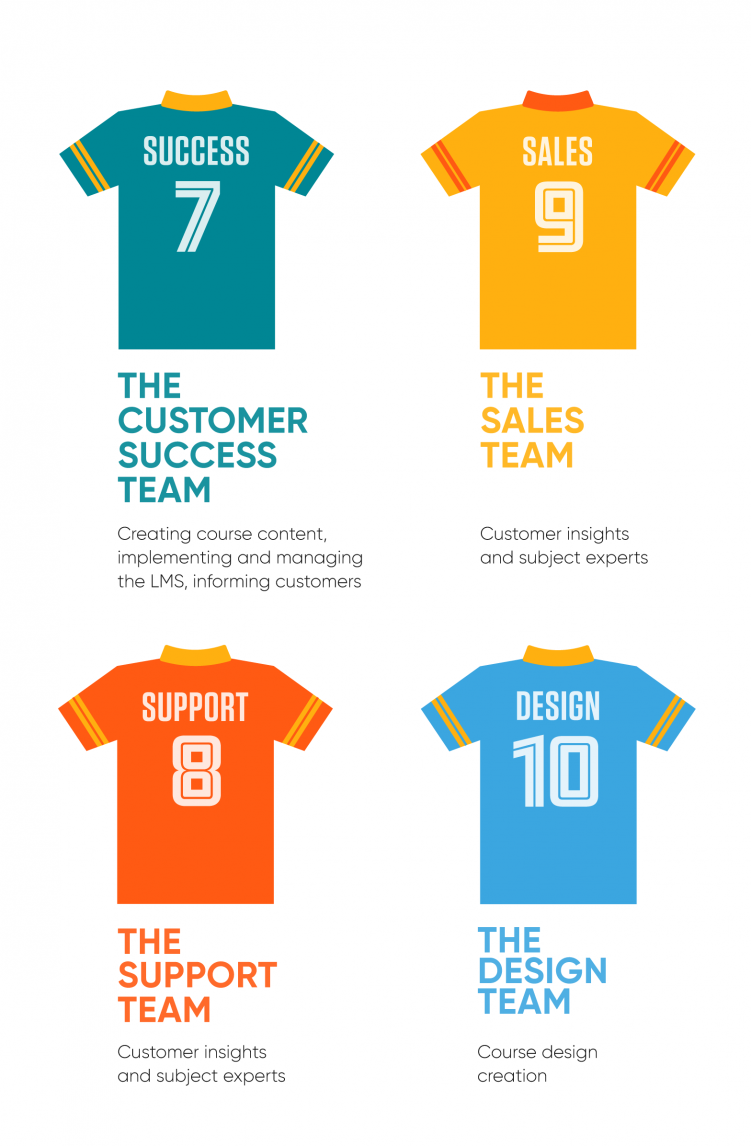
6 min reading time
How to Plan a Customer Education Strategy
Building a university to educate customers isn’t something that happens overnight. While it’s certainly not as complicated as you’d think, it definitely needs to be thought through before implementing.
We’ve seen first-hand that organizations’ with well-planned online customer training strategies that take time to understand their audience, assess their content needs, have a firm grip on their targets, and are more likely to hit the nail on the head. They are the ones that achieve meaningful results. Whereas those who charge ahead without much thought, frequently miss the mark and end up wasting time, money, and resources.
Let’s take a look at how you can follow the below steps to create an attainable and achievable training plan.
It’s a team effort
Typically, a customer training program is owned by one team. For example, at LearnUpon, it’s the Customer Success team. However, that doesn’t mean that other teams shouldn’t be involved – each one can bring their specialized knowledge and strengths to the project.
If you look at your customer’s journey with your organization, it’s likely they’ll interact and receive information from multiple sources. With this in mind, your training stakeholders need to be considered – you need to be aware of which teams are involved with customer training, the skills or strengths each team can offer, and make sure they each know their role.
Every organization differs when it comes to who’s involved and their level of involvement. For our team, we decided to list out every stakeholder that we believed would need to be involved in the process and what their role would be. We knew that our Sales and Support teams played a big part in how customers learn about our product. And, we knew that although we could create courses, we needed skills from other teams to make them look their best. From here, we planned out our stakeholders, and here’s an example of what that looked like:
- The Customer Success Team – Creating course content, implementing and managing the LMS, informing customers
- The Sales Team – Customer insights and subject matter experts
- The Support Team – Customer insights and subject matter experts
- The Design Team – Course design creation

This outlines involvement at a high-level. You can make it much more detailed, if necessary, by outlining the specific team members involved, the tasks that they will be assigned, and the delivery date for each one.
The research phase
It’s tricky to make the right steps to advance your customer training if you’re not sure what exactly is happening in your organization right now. Therefore, it’s good practice to perform a process audit to identify where your organization’s current strategy stands. But what exactly does this entail?
For us, we started by asking:
- What training and resources are we currently giving our customers?
Anything ranging from formal guides, to structured information shared on calls, to back and forth emails with nuggets of advice. Getting all this content in order gives your team a full overview of what training is already taking place.
- What teams are involved in customer training?
Although the Customer Success team typically owns customer training, that doesn’t mean that they aren’t learning from other teams or touchpoints. So, investigate what else is being shared with your customers.
- What tools are we currently using to train our customers?
Do you currently develop training materials? If so, what tools do you use? Or, does your organization already have an LMS? If so, is it suitable for customer training? Assessing all the tools you already use will help you identify what you might and might not need to implement your strategy.
- What is your internal data telling you?
Records in your CRM, the number of tickets logged in your support system – these will provide you with insightful data about what your customers really want to know. By looking at this information, you will discover trends, knowledge gaps, and opportunities for training.
- What are your internal teams and customers saying?
The stats and processes are all key pieces of the puzzle, but equally valuable is qualitative research. Approach your internal teams and ask them what topics they believe should be featured in your training courses and what gaps they see in your current strategy. Don’t forget to ask your own customers too. By asking customers who’ve already been through the process, you’ll get an honest appraisal of the training they received, offering insight into where your training strategy needs improvement.
Develop learning objectives
The research process may come across as tedious. But for our team, it helped with one important thing – learning objectives.
We had an overall goal for developing an online training strategy – adoption and retention – but the data we collated assisted us in creating objectives and outcomes to plan our courses around.
Concrete learning objectives are a necessary task, as they help your team develop courses that have a definitive outcome for the learner.
For example, if you’re training a customer on how to use email software, the objective of a course could be that the user can add a CSV email list to your system. Or, for us at LearnUpon, one objective is that a customer can build a course using our solution. This sounds simple, but it makes creating courses much more straightforward.
An easy step to pass over, but researching and planning your training helps your organization in the long run. From streamlining course creation to defining KPIs, it’s a stage that boosts your chances of getting training right.
Divide and conquer
Through learning objective research and development, you should have an idea of how many courses you’ll need for the training program. Whether it’s 10, 20 or 50, we suggest dividing them out between your team to make the workload more manageable, and achievable.
It’s likely different members of your team will have different skill sets too. So, let’s make life easier on you and your team by aligning those skills to the applicable courses. If a team member is knowledgeable about a specific area of your product, has a large number of customers that deal with a common issue, or if they’re simply experienced in video making and editing, then take advantage of their expertise. This will make course creation a much smoother process.
Follow the rules
Not every team member writes in the same style, explains things in the same terms, or formats their courses in the same structure. With so many hands on deck, it’s essential that your team has a formalized structure for course creation.
The reason? Without it, there’ll be no cohesion to your content, it won’t reflect your organization’s tone, and critically, it could confuse your customers.
Creating a course structure document that outlines how courses should look, read, and be formatted will marry all the courses together to create a definitive style. It should also include how you plan to assess your learners, to demonstrate that learning has taken place. A rule that we like to use is that every course needs to end with an exam, as well as containing interactive elements that actively get customers to engage with your product or service throughout the process.
At LearnUpon, we also leaned heavily on our “One Voice” document – a company-wide manual that instructed us on how we should write about our product. It outlined how to spell certain words and how to refer to our product and its features so that in the end we created a unified learning experience.
Building the content
Topic and structure in hand, it’s time to start creating the course content. There are a lot of avenues you can take to achieve this. However, in the beginning, it’s best to start small and go from there. Focusing on simple slide decks with images, creating PDFs, and other easy to build text and image-based courses help you to develop your skills.
From here, you can branch out into videos using tools like Camtasia or a fully-fledged authoring tool like Articulate Rise or Elucidat. It’s also important to mix-and-match content types. A good LMS will allow you to add multiple content formats to your courses, and by doing this, you’ll keep your learners engaged.
Don’t forget to dig into the resources you already have to hand. Whether it’s eBooks written by Marketing, decks handed out by Sales, or internal guides, take a look at these assets to see if they’re fit for repurposing into courses.
As we mentioned in the planning stage, not every job can be done by one team. There will inevitably be skills gaps. At LearnUpon, our Customer Success team doesn’t have the skills to make high-quality images and videos alone. We tackled this by involving our Design team. By asking them to make assets for our courses, we knew we would meet our high standards and our customers’ expectations.
Go for the MVP
Building a customer training program through a university is an iterative process. It’s unlikely that your organization will be able to create every single course you want in time for launch, or that the content you create will be 100% perfect.
The rule of thumb is to focus on what’s most important from the get-go, what content will your customers get the most value out of? Starting from here will make the whole process more achievable, set expectations, and allow you to continue to add and improve your courses in the long run.




